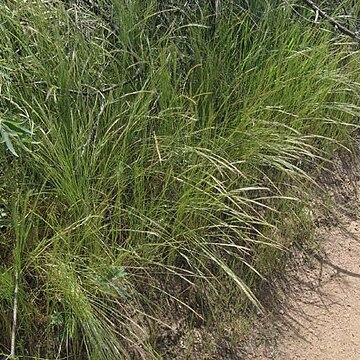Culms 5–70 cm high. Leaf blade 4.5–17 cm long, 0.4–1.7 mm wide, with nerves equally prominent. Inflorescences appearing symmetrical, usually only partially exserted, 7.5–39 cm long. Spikelets 7.7–13 mm long, disarticulating above glumes, with 3–6 bisexual florets and 1 or 2 distal incomplete florets; rachilla minutely scabrous. Glumes: lower glume 0.4–1.5 (–3) mm long, keeled (or dorsally rounded in minute, scale-like glumes), 1-nerved; upper glume 2.6–5.5 (–7) mm long, muticous or shortly awned, slightly keeled at apex, hyaline to membranous at wide margin, prominently 1 (–3)-nerved with lateral nerves usually short. Callus blunt, 0.2 mm long. Lemma 4.7–8.5 mm long, awned, dorsally rounded, scabrous, particularly on midnerve, towards apex and on margins; nerves 5, obscure; awn 6.4–19.6 mm long. Palea shortly bifid. Stamens 1 or 2. Hilum 2–2.5 mm long.
Tufted annual, 50-700 mm high; culms usually densely fascicled. Leaf blade 20-150 x 0.5-3.0 mm; ligule an unfringed membrane. Inflorescence a spike-like panicle, 50-120 mm long, partially enclosed in uppermost leaf sheath; spikelets usually appressed to central axis. Spikelets 6-10 x 1.5-2.5 mm (excluding awns), green or purplish, laterally compressed; glumes unequal, shorter than spikelet, rounded on back; lower glume 0.5-2.0 mm long, usually scale-like but can be nearly 1/2 as long as upper glume, without nerve or 1-nerved; upper glume 3-6 mm long, acute, 1-3-nerved. Florets 3-7; lemma back rounded, scabrid, awn up to 15 mm long, scaberulous, as long as to longer than body of lemma; callus rounded; anther 0.3-1.0 mm long; ovary apex glabrous. Flowering time Sept.-Nov.
Culms erect or geniculately ascending, 20–70 cm tall, 3–4-noded, smooth. Leaf sheaths loosely overlapping, shorter or lower longer than internodes, smooth, glabrous; leaf blades involute, 7–11 cm × 1–2 mm, adaxial surface pubescent, abaxial surface smooth; ligule 0.2–0.5 mm, truncate. Panicle linear, 10–20 × 0.5–1 cm, loose to somewhat dense, mostly curved or nodding, base enclosed by uppermost leaf sheath or just exserted from it. Spikelets oblong or wedge-shaped, 8–10 mm (excluding awns), florets 4–7; lower glume minute, 1–3 mm, upper glume linear-lanceolate, 3–8 mm, apex acute; lemmas 5–7 mm, back scabrid, 5-veined, margins scabrid or ciliolate, apex acuminate; awn 1.3–1.8 cm. Stamen 1; anther 0.4–1 mm. Caryopsis reddish brown, ca. 4 mm. Fl. and fr. Apr–Jul. 2n = 42.
Erect or ascending annual 1–7 dm; blades slender, commonly involute, 0.5–3 mm wide, usually thinly hairy above; infl a contracted, often rather dense panicle or spike-like raceme 3–25 cm, often not fully exserted from the sheath, the branches variously erect to drooping; spikelets 3–7-fld, 5.5–12 mm (excl. awns); florets only loosely imbricate, the rachilla-joints ca 1 mm; glumes thin, glabrous, subulate, the first 1-veined and mostly 0.5–2.5 mm, the second 3-veined, at least twice as long, 2.3–5.5 mm; lowest lemma 4.5–7 mm, usually scabrous above, with an awn 7.5–22 mm; anther usually 1, under 1 mm; grains 3–4.5 mm; 2n=14, 42. Native of Europe, now a widespread weed in temp. and subtrop. regions. (Festuca m.; V. megalura, with ciliate-margined lemmas)
Annual.. Culms 10–70 cm. high, tufted or solitary, erect or geniculately ascending, slender.. Leaf-blades 2–15 cm. long and 0.5–3 mm. wide, flat or rolled, firm to flaccid, rough on the margins, puberulous above.. Panicle linear, 5–30 cm. long, loose to somewhat dense, mostly curved or nodding, enclosed below by the uppermost sheath, or just exserted from it.. Spikelets oblong or wedge-shaped, 7–10 mm. long (excluding awns), 3–7-flowered, green or purplish; lower glume linear-lanceolate, 1–3 mm. long; upper glume subulate-lanceolate, 3–8 mm. long; lemmas 5–7 mm. long, scabrid, tipped with a scaberulous awn up to 15 mm. long; anther usually 1, 0.3–1 mm. long.
Tufted annual 50-700 mm high; culms usually densely fascicled. Leaf blade 20-150 x 0.5-3.0 mm. Inflorescence 50-120 mm long, partially enclosed in uppermost leaf sheath; spikelets usually adpressed to the central axis. Spikelet 6-10 x 1.5-2.5 mm (excluding awns), green or purplish, 3-7-flowered; lower glume 0.5-2.0 mm long, usually scale-like, but can be to nearly 1/2 as long as upper glume; upper glume 3-6 mm long, acute, 1-3-nerved; lemma scabrid, awn up to 15 mm long, scaberulous; callus rounded; anther 0.3-1.0 mm long.
Annual; up to 0.7 m high; tufted. Culms usually densely fascicled. Leaf blades 20-150 x 0.5-3.0 mm. Flowers: panicle open; 50-120 mm long; partially enclosed in uppermost leaf sheaths; spikelets 6-10 mm long; excluding awns; usually appressed to central axis; lower glume 0.5-2.0 mm long; often scale-like or to nearly 1/2 as long as upper; upper glume 3-6 mm long; acute; callus of lemma rounded.
Annual, up to 0.7 m tall. Leaves linear; ligule an unfringed membrane. Inflorescence a panicle, not fully exserted from uppermost leaf. Spikelets 6-10 mm long (excluding awns), many-flowered; glumes unequal, shorter than spikelet, lower less than half as long as upper glume; lemmas tapering into awn 1-2 times as long, straight, not basally twisted.
Like V. bromoides but panicle partly enclosed in upper leaf sheath, lower glume always less than half a long as upper glume.

